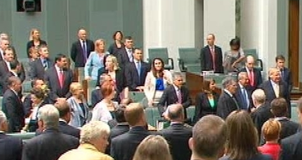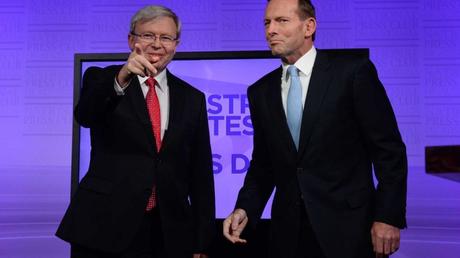 NOW THAT the election date has been set, the optimists among us might hope that attention will turn to policies.
NOW THAT the election date has been set, the optimists among us might hope that attention will turn to policies.
There does seem more awareness this time around that policies and policy analysis are big gaps in how Australian elections are conducted, reported and debated.
Election policies are designed to win elections .. They are not designed to solve complex or long-term policy problems.
For a start, we don't have the policy manifestos that British parties put out in the first or second week of their campaigns. Those long, detailed documents tend to include some grand (and not uncontroversial) plans such as David Cameron's 2010 idea for a ''Big Society''.
In Australia, the closest we get to these are the parties' campaign launch policy speeches, traditionally held at the start of the campaign. But, in the 1990s, the parties recognised that holding these events early worked against them. Their opponents and the media then had plenty of time to find even small errors in the detail or costings of policies. And releasing all of their major policies in one go meant that it was difficult to sustain media attention across the five or six weeks of the campaign.
By 2010, the campaign ''launch'' was a misnomer. The Coalition held its ''launch'' only 13 days from polling day while the Labor Party gave voters even less time to reflect, just five days.
Before we get to those events at this election, we will see hundreds of small, individual policies trickle out over the next month. Policies are delivered in piecemeal fashion because it fits with the daily, media-focused campaign cycle. But it's also because the parties like small policies.
Election policies are designed to win elections. They are carefully crafted to target (or appease) specific sections of the electorate. They are not designed to solve complex or long-term policy problems.
Some of the biggest [issues] include planning for an ageing Australia, the mismatch between government revenues and spending, and the ''barbecue stopper'' issue of work/life balance
So, if recent elections are any guide, during this campaign we should expect announcements about pension increases for senior Australians, promises to create more childcare places or extra childcare funding, funding for new roads - especially in marginal seats - and promises to reduce red tape for small businesses.
There will also be small but heavily promoted policies about education. Labor has a consistent theme here. Bob Hawke promised in 1983 to equip secondary schools with computers. So did Paul Keating in 1996 and Kevin Rudd in 2007. The Coalition tends to take a different angle. Both John Howard in 2007 and Tony Abbott in 2010 promised parents help with school fees.
We will see many small policies that tinker at the edges rather than bold attempts to address big, systemic problems or outline major policy visions. The usual view of this lack of policy ambition is that it is a strategic choice by the parties because ''big visions are big targets'' and no one wants to get caught out on the finer detail of grand policies. Ever since John Hewson's Fightback! manifesto went awry, the parties have steered away from big plans during elections and tend to set only modest policy goals.
But the newer, and scarier, theory is that the parties just can't do long-term, detailed policy planning any more because of a range of factors. These include the parties' own internal processes, their hollowing out, lack of connection with citizens and communities, and lack of attention to policy research and development.
Creaky 19th-century political structures are trying to function in a globalising world where national leadership means less than it used to, and where there is a high degree of interconnectivity, complexity and rapid speeds in information, technology and communications.
Former lobbyist and ministerial adviser Mark Triffitt, who spent two decades observing policy processes, is concluding in his PhD research that politicians can no longer deliver ''sound, forward-looking policy in any consistent or coherent way'' because of ''deep, systemic problems with our liberal democratic system itself''.
So what are the big policies that need to be tackled but probably won't be during this campaign? Some of the biggest include planning for an ageing Australia, the mismatch between government revenues and spending, and the ''barbecue stopper'' issue of work/life balance that Howard flagged more than a decade ago.
There is also planning to meet the opportunities and challenges that have come with unprecedented growth in China and India (which Keating identified 17 years ago).
There are changes to the political system that aren't in the major parties' self-interest but somehow still need to be made. Inequality and poverty are perennial ''big issues'' that were mentioned in some of the first policy speeches made in the early 1900s. A more recent issue that's firmly of our time is how to ensure the future of journalism in a country that ranks poorly on international rankings of press freedom. Australia is ranked 26th in the Reporters Without Borders' World Press Freedom Index behind New Zealand (8th), Sweden (10th), Ireland (15th) and Canada (20th).
But if policy development is suffering, there are at least signs of growth in policy analysis. For example, for the first time, there is now a single repository keeping all of the major parties' policies in one place for comparison at the Election Watch website at the University of Melbourne. This is one initiative among several others through newspapers, public broadcasting and independent outlets seeking to fill the gap in analysis. Now it's up to the parties to come up with the content and the big ideas, if they can.
This article was originally published in The Age, 7.8.13




